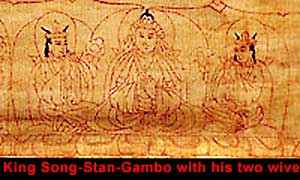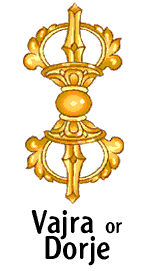The
practice of printing manuscript and prayer flag is very much depended
upon the beliefs of Tibetan religious life. Actually this process was
introduced from China to Tibet for some kind of religious need. Therefore
it cannot be compared with modern day fine print making.
So for appreciating this tradition fully, we need to understand the
social, cultural and religious beliefs of Tibetan community. Then it
will be much clear to us, how this technique got a fertile ground for
its development in this particular community.
Tibet had one kind of a Shamanistic belief which
was originated at her own ground. The beginning of this belief is quiet
uncertain as presence of such animistic religion is common in the beginning
of any human society. The name of this pre-Buddhist Tibetan folk religion
is BON-PO.Practice of this religion was magical rites, sacrifice and
worship of wrathful deities. From this inheritance an ever lasting attraction
toward magical performances and Shamanistic approach was well grooved
in the depth of Tibetan mind.
 Buddhism was first introduced in Tibet in time of king Songsten Gampo
in 6th century. Mahayana or ‘Greater vehicle’ or ‘northern Buddhism’
was introduced there. In Emperor Trisong Detsen’s reign Indian Buddhist
monk and scholar Santarakhshita, was invited to Tibet. He established
Tibet’s first monastery at Samye. At that time tantric guru PadmaSambhava,
the most respected religious hero of Tibet came from Swatt valley of
Pakistan. He is often called Vajra gura Rimpoche in Tibetan. When Guru
Padma Sambhava came, he saw the entire land is spellbound by Bonpo priests.
He converted the followers of Bonpo religion to Buddhism, assimilated
some of their occult practices and accepted some Bonpo deities in Mahayana
iconography as wrathful delties or Dharmapalas (Dharma Protecting deities).
Actually it was guru PadmaSambhava, for whose effort Buddhism took the
most important place in Tibetan life for centuries .
Buddhism was first introduced in Tibet in time of king Songsten Gampo
in 6th century. Mahayana or ‘Greater vehicle’ or ‘northern Buddhism’
was introduced there. In Emperor Trisong Detsen’s reign Indian Buddhist
monk and scholar Santarakhshita, was invited to Tibet. He established
Tibet’s first monastery at Samye. At that time tantric guru PadmaSambhava,
the most respected religious hero of Tibet came from Swatt valley of
Pakistan. He is often called Vajra gura Rimpoche in Tibetan. When Guru
Padma Sambhava came, he saw the entire land is spellbound by Bonpo priests.
He converted the followers of Bonpo religion to Buddhism, assimilated
some of their occult practices and accepted some Bonpo deities in Mahayana
iconography as wrathful delties or Dharmapalas (Dharma Protecting deities).
Actually it was guru PadmaSambhava, for whose effort Buddhism took the
most important place in Tibetan life for centuries .
The Schools of Tibetan Buddhism derived from Indian
Mahayana tradition. The four main Schools are (1) NYINGMAPA ( the old
school) founded 8th centuries by Guru Rimpoche. (2) SAKYAPA whcih schools
Indian lineage derived for mahasiddha Birupa, an enlighened tantrika
and transmitted to Tibet by Drokmi Lotsawa. (3)KAGYUPA school was founded
arround 10th -11th century. The lineage of them is derived from Indian
mahasiddha Tilopa to Naropa to Marpa and to Milarepa.
The KADAMPA school was founded be Atisha Dipankara (10-47-54), famous
Buddhist scholer from Bengal, Later it was absorbed by the fourth major
school - GYELUKPA (The yellow hat) School. This school was founded by
Tsonkhapa. He had his lineage from Dipankara's disciple Dom-Stonpa.
Dalai Lama, the religious leader of Tibetan Buddhists, comes from this
gyelukpa sect. There are few other sects also besides these major schools.
However all these sects belong to Mahayana tradition and
their teaching and practice put great emphasis on studying Mahayana
sutras, and practice of meditation, tantra and yoga; although the practice
varies from school to School.
So for this study of Buddhist philosophy a huge amount
of Buddhist texts to Tibetan language. They did this huge job between
7th to 13th Century with the pely of Indian scholars. All the manuscript
we find this period is hand-written.
Tibetan emperor Songtsen Gampo commissioned his minister
Thonmi - Sambhot for devloping a Tibetan script. Thomni Sambhot adapted
Sanskrit alphabet and made Tibetan phonetic script based on Brahmi
. The Tibetan scripture is mainly two types ‘Uchen’ and ‘Umed’. ‘Uchen’
is formal script and ‘Umed’ is used for quick writing. generally ‘uchen’
is used in every types of text writing.
After 14th century when the craft of printing was introduced from china
to Tibet, the Tibetan took the advantage of this unique technology for
copying this huge amount of texts. Buddhism always enjoyed great support
and patronage from the ruler of the of the state and common people in
Tibet. Numerous monasteries and universities were built in the entire
country during the flourish of the religion. This gompas or monasteries
were the main educational institution of this country. For the study
of the students of this institutions, the mass production of texts was
needed. So the practice of printing got a very enthusiastic atmosphere.
But the expansion of use of printing on other areas beside
copying manuscript was patronized by tantric practice. One of such area is printed banner or prayer flags. The type of Tantric ways and ritual
practiced among Tibetan community is Mantrayana or the vehicle of Mantra.
In this way mantra is considered the chief means of salvation. A mantra
is thought as a condensed and most concentrated expression of an energy
or concept within a few sounds. Art historian Philip Rawson wrote about
this:-
is printed banner or prayer flags. The type of Tantric ways and ritual
practiced among Tibetan community is Mantrayana or the vehicle of Mantra.
In this way mantra is considered the chief means of salvation. A mantra
is thought as a condensed and most concentrated expression of an energy
or concept within a few sounds. Art historian Philip Rawson wrote about
this:-
“A mantra is felt to be a sort of nucleus on gathering point for,
energy or concentrated from of cosmic power. To utter one correctly
(Which needs patient study and effort) evokes from the interfused structure
of man and cosmos for the specific force to which is related”.
So according to such belief reciting the mantra repeatedly is a method
of attaining spiritual merit of the practitioner -
“The mantras which concern us here, however are those with a ritual
purpose. They may be recited voiced on voicelessly, thousand of times
over in what is called ‘JAPA’, so as to produce a cumulative stream
of energy. On cloth mantras may be woven or printed many times over
as a visual equivalent of Japa”.
In any monastery, village or locality of Tibetan
community, we see men and women are doing japa by counting beads or
with japayantra- a cylindrical device at one side of which a bead is
hanging and it is rotating along its axis on a small stick attached
at its bottom. This japa is the commonest and widest used way for common
people as spiritual practice.
So this process of japa is transferred as an visual expression of mantra
to banner and prayer flags by means of printing. These prayer flags,
It is believed, when lifted, it purifies the air with the mantra and
by air the mantra flow across the space as a prayer of the person who
raised it.
Whether this belief has originated from Shamanistic
bon practice or Mahayana tradition can not be surely ascertained. Such
faith is also very common in Indian mind because Tibetan mind share
so much common elements at the base of their culture with the Indians.
This wish to sanctify the environment,
house on the surrounding and make it worth a place for a deity is not
different from the wish to purify the air with mantra printed on prayer
flags. Famous artist and theoritician K.G. Subramanyan
wrote in his essay "Religion and art in India"-
"One can trace the Indian concept of metamorphosis rebirth and
trans-substantiation to such a vision. The persistent in Indian notion
of life also probably derives from this. So a devout Indian wishes to
transform his house into a temple, his life into a holy pageant, he
wants to see every thing in his environment transformed, with its ‘
animus’ glowing. His greatest desire is to transform and rarefy himself,
and, at the ultimate, to come off his ‘costume’and to be ‘free’, or
as he would say, attain final release or ‘mukti’.
The recognition of this idea of
transformation and flux as an essential part of Indian life will make
it easy for one to under stand Indian art forms and Indian art activities
in proper perspective".
This desire for sanctification of environment, transform
everything into a transcendental condition and inviting the auspicious
is a common driving force of art activity in this region. Here in prayer
flags the mantra sanctify the environment.
The most auspicious mantra
printed is ‘om mani peme hum’. Which is considered as mantra
of ‘CHENREJIG’(Avolokiteshwara) In its fabric compounds ‘om’ is root syllable of origination, ‘MANI’
means jewel, synonym to ‘vajra’, the word which means ‘thunderbolt’
or ‘wisdom’, ‘PEME’ means ‘padme’ or ‘in the lotus’ or ‘compassion’,
‘Hum’ means the nuclear mantra which represents, Buddha, highest enlightened
being. So the mantra ‘OM MANI PEME HUM’
represents the concept of inseparability of wisdom and compassion in
Vajrayana Buddhism(7). But this six syllable mantra
is also believed by the devotees as a way of salvation where the six
syllable repreasents the six worlds of Hell, Human beings, animals,
demigods, gods and hungry ghosts and who recites the mantra get salvation
from these six worlds.
In its fabric compounds ‘om’ is root syllable of origination, ‘MANI’
means jewel, synonym to ‘vajra’, the word which means ‘thunderbolt’
or ‘wisdom’, ‘PEME’ means ‘padme’ or ‘in the lotus’ or ‘compassion’,
‘Hum’ means the nuclear mantra which represents, Buddha, highest enlightened
being. So the mantra ‘OM MANI PEME HUM’
represents the concept of inseparability of wisdom and compassion in
Vajrayana Buddhism(7). But this six syllable mantra
is also believed by the devotees as a way of salvation where the six
syllable repreasents the six worlds of Hell, Human beings, animals,
demigods, gods and hungry ghosts and who recites the mantra get salvation
from these six worlds.
 The
twelve syllable mantra ‘OM AH HUNG VAJRA GURU PEME SIDDHI HUM’ is considered
as Vajraguru PadmaSambhava’s mantra and evolves his blessing. This is
printed in Vajraguru Thurchok.
The
twelve syllable mantra ‘OM AH HUNG VAJRA GURU PEME SIDDHI HUM’ is considered
as Vajraguru PadmaSambhava’s mantra and evolves his blessing. This is
printed in Vajraguru Thurchok.
At
this discussion now we come to the point that the development and patronization
of this art form is dependant upon some different type of need compared
to modern day practice of art Apart from being a specialized discipline
named fine Art which enjoy the specialized discipline the glamour of
high culture, this practice of printing craft became deeply attached
with social and cultural life of the community. It does not relish the
exhibition value of an art object but always appraised by a different
scale of value – the cult value. Famous
German Art theoretician wrote in his essay, "The work of art in
the age of mechanical reproduction"-
"Originally the contextual integration of art in tradition
found its expression in the cult. We know that the earliest art works
originated in the service of a ritual-first the magical, then the religious
kind. is significant that the existence of work of art with reference
to its aura is never entirely repeated from its ritual function, In
the other words the unique value of the authentic work of art has Its
basis in ritual the location of its original use value".
He further made it distinct that any art could be valued by this different
kind of valuation–
‘‘Works of art are received and valued on different planes. Two
polar types stand out. With one the accent is on the cult value, with
the other, on the exhibition value of work’’.
While discussing about traditional form of printing
one should keep these two different scale of valuation for better appreciation
of this heritage.

